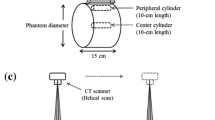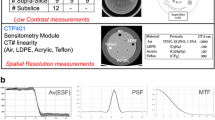Abstract
To determine the optimal display conditions for ultra-high-resolution computed tomography (UHRCT) images in clinical practice, this study investigated the effects of liquid–crystal display (LCD) resolution and displayed image size on the spatial resolution of phantom images acquired using a UHRCT system. A phantom designed to evaluate the high-contrast resolution was scanned. The scan data were reconstructed into four types of UHRCT image series consisting of the following possible combinations: two types of reconstruction kernels on the filtered back-projection method (for the lung and mediastinum) and two types of matrix sizes (10242 and 20482). These images were displayed under eight types of display conditions: three image sizes displayed on a 2-megapixel (MP) and 3-MP color LCD and two image sizes on an 8-MP color LCD. A total of 32 samples (four image series × eight display conditions) were evaluated by eight observers for high-contrast resolution. The high-contrast resolution of the displayed UHRCT images was significantly affected by the displayed image size, although the largest (full-screen) displayed image size did not necessarily show the maximum high-contrast resolution. When the images were displayed in the full-screen size, LCD resolution affected the high-contrast resolution of only the 20482-matrix-size images reconstructed using the lung kernel. In conclusion, the spatial resolution of UHRCT images may be affected by LCD resolution and displayed image size. To optimize the clinical display conditions for UHRCT images, it is necessary to adopt an LCD with an adequate resolution for each viewing situation.





Similar content being viewed by others
References
Hata A, Yanagawa M, Honda O, Kikuchi N, Miyata T, et al. Effect of matrix size on the image quality of ultra-high-resolution CT of the lung: comparison of 512 × 512, 1024 × 1024, and 2048 × 2048. Acad Radiol. 2018;25:869–76.
Kakinuma R, Moriyama N, Muramatsu Y, Gomi S, Suzuki M, et al. Ultra-high-resolution computed tomography of the lung: image quality of a prototype scanner. PLoS ONE. 2015;10: e0137165.
Tanabe N, Oguma T, Sato S, Kubo T, Kozawa S, et al. Quantitative measurement of airway dimensions using ultra-high resolution computed tomography. Respir Invest. 2018;56:489–96.
Yanagawa M, Hata A, Honda O, Kikuchi N, Miyata T, et al. Subjective and objective comparisons of image quality between ultra-high-resolution CT and conventional area detector CT in phantoms and cadaveric human lungs. Eur Radiol. 2018;28:5060–8.
Mikayama R, Shirasaka T, Yabuuchi H, Sakai Y, Kojima T, et al. Effect of scan mode and focal spot size in airway dimension measurements for ultra-high-resolution computed tomography of chronic obstructive pulmonary disease: a COPDGene phantom study. Phys Med. 2020;70:102–8.
Onishi H, Hori M, Ota T, Nakamoto A, Osuga K, et al. Phantom study of in-stent restenosis at high-spatial-resolution CT. Radiology. 2018;289:255–60.
Yoshioka K, Tanaka R, Takagi H, Ueyama Y, Kikuchi K, et al. Ultra-high-resolution CT angiography of the artery of Adamkiewicz: a feasibility study. Neuroradiology. 2018;60:109–15.
Meijer FJ, Schuijf JD, Vries Jd, Boogaarts HD, Woude Wv, et al. Ultra-high-resolution subtraction CT angiography in the follow-up of treated intracranial aneurysms. Insights Imaging. 2019. https://doi.org/10.1186/s13244-019-0685-y.
Tanaka R, Yoshioka K, Takagi H, Schuijf JD, Arakita K. Novel developments in non-invasive imaging of peripheral arterial disease with CT: experience with state-of-the-art, ultra-high-resolution CT and subtraction imaging. Clin Radiol. 2019;74:51–8.
Hino T, Kamitani T, Sagiyama K, Yamasaki Y, Matsuura Y, et al. Detectability of the artery of Adamkiewicz on computed tomography angiography of the aorta by using ultra-high-resolution computed tomography. Jpn J Radiol. 2020;38:658–65.
Yamashita K, Hiwatashi A, Togao O, Kikuchi K, Matsumoto N, et al. Ultrahigh-resolution CT scan of the temporal bone. Eur Arch Otorhinolaryngol. 2018;275:2797–803.
Akazawa Y, Ganaha A, Higa T, Kondo S, Oyakawa Y, et al. Measurement of stapes footplate thickness in otosclerosis by ultra-high-resolution computed tomography. Acta Otolaryngol. 2020;140:899–903.
Ohara A, Machida H, Shiga H, Yamamura W, Yokoyama K. Improved image quality of temporal bone CT with an ultrahigh-resolution CT scanner: clinical pilot studies. Jpn J Radiol. 2020;38:878–83.
Miyamoto M, Ohara A, Arai T, Koyanagi M, Watanabe I, et al. Three-dimensional imaging of vocalizing larynx by ultra-high-resolution computed tomography. Eur Arch Otorhinolaryngol. 2019;276:3159–64.
Bacher K, Smeets P, Hauwerea AD, Voet T, Duyck P, et al. Image quality performance of liquid crystal display systems: Influence of display resolution, magnification and window settings on contrast-detail detection. Eur J Radiol. 2006;58:471–9.
Kamitani T, Yabuuchi H, Soeda H, Matsuo Y, Okafuji T, et al. Detection of masses and microcalcifications of breast cancer on digital mammograms: comparison among hard-copy film, 3-megapixel liquid crystal display (LCD) monitors and 5-megapixel LCD monitors: an observer performance study. Eur Radiol. 2007;17:1365–71.
Samei E, Ranger NT, Delong DM. A comparative contrast-detail study of five medical displays. Med Phys. 2008;35:1358–64.
Nishimura A, Ichikawa K, Mochiya Y, Morishita A, Kawashima H, et al. Preliminary investigation of the clinical usefulness of super-high-resolution LCDs with 9 and 15 mega-sub-pixels: observation studies with phantoms. Radiol Phys Technol. 2010;3:70–7.
Horii A, Kataoka C, Yokoyama D, Fujita N, Yasuda N, et al. Comparison of the detection rates in reduced image by difference of interpolation method. Proc SPIE Med Imaging. 2011;7966:79661E.
Friedenberg A. Sampling-interpolation modulation transfer function as the envelope of the interpolated output. Oct Eng. 2000;39:520–6.
Sprawls P. AAPM tutorial: CT image detail and noise. Radiographics. 1992;12:1041–6.
Ziegler A, Köhler T, Proksa R. Noise and resolution in images reconstructed with FBP and OSC algorithms for CT. Med Phys. 2007;34:585–98.
Huda W, Abrahams RB. X-ray-based medical imaging and resolution. AJR Am J Roentgenol. 2015;204:W393–7.
Acknowledgements
The authors thank Mr. Masahiro Koike and Mr. Shohei Kudomi (Yamaguchi University Hospital, Ube, Japan) for his technical advice, and Dr. Seiichi Murakami, Dr. Yasuyuki Kawaji, Dr. Noriyuki Kuga, Dr. Yutaka Yoshida, Ms. Aiko Ohmaru, and Dr. Yuji Tsutsui (Junshin Gakuen University, Fukuoka, Japan) for participating in our observational experiments.
Funding
The three display monitors used in this study were provided by EIZO Corporation.
Author information
Authors and Affiliations
Corresponding author
Ethics declarations
Conflict of interest
J. Morishita received a research grant from the EIZO Corporation (Ishikawa, Japan). N. Hashimoto is a member of EIZO Corporation.
Ethical approval
All procedures performed in studies involving human participants were in accordance with the ethical standards of the Institutional Review Board (IRB) and with the 1964 Helsinki declaration and its later amendments or comparable ethical standards. This article does not contain any animal studies.
Informed consent
Informed consent was obtained from all individual participants included in the study.
Additional information
Publisher's Note
Springer Nature remains neutral with regard to jurisdictional claims in published maps and institutional affiliations.
About this article
Cite this article
Ikushima, Y., Tokurei, S., Sato, S. et al. Influence of monitor display resolution and displayed image size on the spatial resolution of ultra-high-resolution CT images: a phantom study. Radiol Phys Technol 15, 147–155 (2022). https://doi.org/10.1007/s12194-022-00656-4
Received:
Revised:
Accepted:
Published:
Issue Date:
DOI: https://doi.org/10.1007/s12194-022-00656-4




